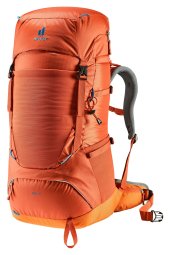Are you heading out for a hike for the first time, or are you an experienced adventurer? Choosing the right backpack is an important yet relatively complex task that can determine the overall experience of your planned outdoor activity. The variety of types, features, and parameters can be confusing, such as choosing between different back systems or the differences in capacity and materials. With our guide, however, you will easily find a model that suits your needs. This article will help you navigate the options, choose the ideal backpack, and avoid common purchasing mistakes. Additionally, you'll get practical tips for properly adjusting and caring for your backpack to ensure it lasts as long as possible. Whether you're a beginner or a seasoned hiker, we'll help you make an informed decision that your back and shoulders will thank you for.
Contents:
- Why Choosing the Right Backpack is Key
- The Difference Between a Trekking Backpack and a Hiking Backpack
- What Types of Backpacks Are There?
- Hiking Backpacks (Smaller Capacity)
- Trekking & Expedition Backpacks
- Child Carriers
- Specialty Backpacks for Outdoor Activities
- Backpacks for Women
- Daypacks for Hiking
- Main Parameters for Choosing a Backpack
- Volume and Capacity
- Backpack Weight - Robust vs. Lightweight
- Materials and Durability - Quality That Pays Off
- Adjustable Features - Relieve Your Shoulders and Keep Your Back Comfortable
- Back System Ventilation - Venting Against Unpleasant Sweating
- Price/Performance Ratio
- How to Properly Adjust a Backpack
- How to Pack and Fill a Backpack
- Accessories and Features You'll Appreciate
- The Most Common Mistakes When Choosing a Backpack
- How to Care for Your Backpack
- FAQ – Frequently Asked Questions
- Conclusion
Why Choosing the Right Backpack is Key
A properly chosen backpack can determine whether your hike is a pleasant experience or an ordeal. An ill-fitting backpack can cause back pain, shoulder aches, and chafing. In addition to physical comfort, it also affects the efficiency of carrying your gear and your speed of movement. A poor choice of backpack leads to rapid material wear, which means unnecessary expenses for repairs or replacement. For hiking and expedition trips, the right choice is also crucial for safety during the journey. Remember, a well-chosen piece of luggage will become your reliable partner, allowing you to enjoy every step. For example, on long mountain hikes, an anatomically well-adjusted backpack will help you significantly reduce fatigue and prevent back pain, allowing you to fully concentrate on the beauty of the surrounding nature.
The Difference Between a Trekking Backpack and a Hiking Backpack
A trekking backpack and a hiking daypack differ primarily in their construction and purpose. A trekking backpack is larger and more robust, designed for carrying heavier loads over longer distances. It usually has a sturdy frame that distributes weight to the hips and offers a larger volume for gear like a sleeping bag, tent, or food supplies. In contrast, a hiking daypack is lighter and more compact, suitable for shorter trips or day hikes. Due to its smaller size, it is easy to carry and ideal for carrying essential gear like a water bottle, snacks, and light clothing.
What Types of Backpacks Are There?
Hiking Backpacks (Smaller Capacity)
- Ideal for shorter trips or less demanding hikes.
- Usually up to 50 liters in volume.
- Lightweight construction and easy to carry.
Trekking & Expedition Backpacks
- Suitable for long expeditions and heavy loads.
- Volume over 50 liters, often with an integrated frame.
- Offer better stability and larger storage compartments.
Child Carriers
- Designed for comfortably carrying children.
- Special construction with an emphasis on safety, stability, and ergonomics.
- Often include extra padding and safety features.
- A child carrier is a great alternative to soft carriers and considers comfort for both the parent and the child.
Tip: When choosing the ideal child carrier, get inspired by the practical tips in our guide and enjoy every adventure to the fullest, even with a young child.
Specialty Backpacks for Outdoor Activities
- Designed for specific purposes, such as hunting, photography, or mountaineering.
- Offer unique features like gear holders, specialized loops, and pockets.
Backpacks for Women
- Specially designed to fit the female anatomy.
- Narrower shoulder straps and shorter back systems.
- Lighter construction and stylish design.
Daypacks for Hiking
- An alternative to smaller trekking backpacks, suitable for shorter routes like light treks, hiking in nature parks, or urban excursions.
- Volume typically around 30 liters.
- A hiking daypack is lighter and more compact, often without a robust back system.
Tip: For outdoor enthusiasts, we have prepared a practical guide on how to choose a hiking backpack.
Main Parameters for Choosing a Backpack
Volume and Capacity
- Shorter hikes: up to 40 liters.
- Multi-day trips: 50–70 liters.
- Expeditions: over 70 liters.
The size of the backpack should correspond not only to the length of the expedition but also to the amount of gear carried. For example, with smaller backpacks up to 40 liters, the internal space is ideal for short trips where you only need to pack basic clothing, snacks, and water. Medium backpacks with a volume of 50–70 liters can hold gear for multi-day hikes, such as a sleeping bag, stove, change of clothes, and food supplies. For long expeditions over 70 liters, you need to account for space for larger food supplies, winter clothing, a tent, and other essential equipment.
What to consider for multi-day hikes, i.e., what you will be carrying:
- Food and drink: You should have enough space for packaged food, a hydration reservoir, or water bottles.
- Sleeping: A sleeping bag and mat take up a lot of volume, especially in colder seasons.
- Clothing: For multiple days, you need to pack enough layers, including waterproof clothing.
- Cooking: Space for a stove, fuel canisters, and cookware.
- First aid and basic gear: First aid kit, knife, headlamp, and basic repair tools.
Tip: Think about the season and type of gear – winter hikes require more space.
Tip: It's also useful to consider whether you will be sharing gear with other members of your party and if you can split some items.
Backpack Weight - Robust vs. Lightweight
- Lighter models are easier to carry but may be less durable.
- With heavier backpacks, pay attention to quality padding and a well-designed back system.
- Compare the weight of the empty backpack with its load capacity.
- A balance between robustness and comfort is important.
Materials and Durability - Quality That Pays Off
- Water-resistant and strong materials extend the life of the backpack.
- Suitable and high-quality materials like nylon or ripstop ensure tear resistance.
- Waterproofing treatment increases resistance to moisture.
- Some models offer UV protection for longer life in harsh conditions.
Adjustable Features - Relieve Your Shoulders and Keep Your Back Comfortable
- Quality padded hip belt
- Shoulder straps with adjustability and a sternum strap
- Adjustable back system for comfortable carrying
- The ability for individual adjustment is key to comfort and effective weight distribution.
- Check that the adjustments match your height and build.
- Models with a simple adjustment system for on-the-go changes are useful.
Back System Ventilation - Venting Against Unpleasant Sweating
- Some backpacks have integrated ventilation panels that reduce sweating.
- They are especially suitable for summer hikes and more strenuous activities.
- Mesh and foam panels ensure airflow, comfort, and back ventilation.
Price/Performance Ratio
- When choosing, consider how often you will be carrying the backpack and under what demanding conditions.
- More expensive models offer higher durability, ergonomics, and accessories.
- Cheaper models may be suitable for occasional trips.
How to Properly Adjust a Backpack
- Loosen all the straps.
- Put the backpack on a level surface. Stability ensures you can easily adjust the backpack, put it on correctly, and securely fasten all straps without losing balance or having trouble handling it. In unbalanced conditions, such as on uneven terrain, adjusting and putting it on can be more difficult.
- Fasten the hip belt and tighten it so it carries most of the weight.
- Adjust the shoulder straps so the backpack fits snugly against your back.
- Secure the sternum strap for stability and to prevent the shoulder straps from slipping.
- Pay attention to the weight distribution inside the backpack.
- Consider whether you have easy access to frequently used items without having to take the backpack off.
Tip: Try the backpack with a full load before your first hike to identify any potential discomfort.
How to Pack and Fill a Backpack
- Weight Distribution:
- Place heavier items as close to your back as possible to maintain a stable center of gravity.
- Lighter items and clothing can go on top or on the sides.
- Gear Separation:
- Use compartments and pockets for organization.
- Don't forget quick-access items like water, a rain cover, a map, or a snack.
- Clarity:
- Keep the backpack organized so you don't have to unpack the entire contents to find one item.
- For items you need at hand, use practical pockets on the hip belt, for example.
- Load Compression:
- Use compression straps to reduce volume and increase stability.
Tip: If you want to learn more about properly packing bulky gear, read how to properly pack things into a backpack.
Hydration Tip: Make sure you have easy access to water using a hydration reservoir or a bottle stored in a side pocket.
Accessories and Features You'll Appreciate
- Rain cover - integrated into a bottom pocket for protection from rain.
- Quality padded back panel.
- Hydration reservoir or a sleeve for it for easy access to fluids.
- Pockets for organizing small items, valuables, and basic gear.
- Top and side access for easier packing, finding, and organizing.
- Gear attachment system on the outside of the backpack - e.g., trekking poles, ice axe, and sleeping pad don't have to take up space inside.
- Removable parts – some models offer a removable top lid that can be used as a practical small daypack.
- Reflective elements to increase safety when moving in low light and other poor visibility conditions.
- Functional back systems:
- Modern backpacks use designs that distribute weight across the entire back surface.
- Tensioned mesh or anatomical padding minimizes pressure on specific points.
The Most Common Mistakes When Choosing a Backpack
- Volume too large or too small. A larger backpack usually tempts you to carry unnecessary items and excessive load. A small backpack, on the other hand, may not fit everything important.
- Ignoring adjustable features. A quality back system on a well-chosen backpack can be adjusted precisely to your body.
- Underestimating material quality. Choose backpacks made of durable material. The most stressed parts of a backpack are usually the buckles and seams, so we recommend focusing on these elements.
- Not trying the backpack on before buying. Choosing the right backpack for your body can be tricky. That's why we offer the option of a no-obligation trial at our store.
- Choosing the wrong type of backpack for the planned activity. The backpack should match its purpose. Whether you're planning multi-day treks or short expeditions, consider your intentions when choosing.
- Overloading the backpack beyond its capacity. Most backpacks state a maximum load capacity that is not advisable to exceed. Both the backpack and your back will thank you for it.
How to Care for Your Backpack
- After use, let it air dry.
- Regularly check zippers and seams.
- Store in a dry, dark place.
- Clean the backpack according to the manufacturer's instructions. Do not use aggressive cleaning agents.
- Treat the material with a waterproofing agent to maintain its water resistance.
- Repair minor damage promptly to prevent major problems.
- For long-term storage, remove all gear and let the empty backpack air out.
FAQ – Frequently Asked Questions
- What backpack volume is ideal for multi-day hikes? A volume of 50–70 liters should be sufficient.
- How do I know if the backpack fits me correctly? Most of the weight should rest on your hips, not your shoulders.
- Can I use a hiking backpack for regular travel? Yes, but for longer trips and vacations, travel bags or suitcases are more suitable.
- What is the difference between an expedition backpack and a regular backpack? Expedition backpacks have a larger volume and a better carrying system.
- How do I care for the water resistance of my backpack? Use a waterproofing treatment and watch for material wear.
- What materials are best for backpack durability? Nylon and polyester are popular for their resistance to water and wear.
- What should I do if my back hurts from carrying a backpack? Check the adjustment of the hip belt and shoulder straps. The weight of the backpack should be evenly distributed.
- Is a backpack with an integrated frame better than one without? Backpacks with a frame are more stable and suitable for heavy loads, while those without a frame are lighter and more compact.
- How long does a quality backpack last? With proper care, a backpack can last for more than ten years.
- How should I pack a backpack to make it comfortable to carry? Place heavier items as close to your back as possible and lighter gear on top or on the sides.
Conclusion
Choosing a backpack for a longer stay in nature can be very challenging, but with the right approach, you will ensure both comfort and efficiency. If you are planning a trek lasting several weeks, it is important to choose a quality backpack where the main compartments facilitate organization, pay attention to the back system, adjustable elements, and don't forget the little things like having a water bottle always at hand.
Invest time in choosing the right size, back system, and accessories that will save you worries. A backpack is not just equipment, but a key part of your adventure. Pay attention to the details and enjoy every journey. With a well-chosen backpack, unforgettable experiences from your travels and hikes await you. Good luck and have a great trip!









